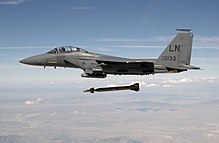GBU-28
It was designed, manufactured, and deployed in less than three weeks due to an urgent need during Operation Desert Storm to penetrate hardened Iraqi command centers located deep underground.
Planners noticed that a few command and control bunkers in Baghdad were located deep underground to withstand heavy fire.
By January 1991, as the Persian Gulf War was well underway, it was determined that the BLU-109/B-equipped laser-guided bombs (LGB) would be unable to penetrate fortified bunkers deep underground.
[7] The initial batch of GBU-28s was built from modified 8-inch (203 mm) artillery barrels (principally from deactivated M110 howitzers), but later examples are purpose-built[8] with the BLU-113 bomb body made by National Forge of Irvine, Pennsylvania.
[9] The GBU-28 C/B version uses the 5,000-pound BLU-122 bomb body, which contains AFX-757 explosive in a 4,000-pound (1,800 kg) casing machined from a single piece of ES-1 Eglin steel alloy.
When the GBU-28 hits the ground, a short-delay time fuze is activated which triggers detonation when it has penetrated deeply enough to completely destroy the target.
The al-Taji Airbase, located 15 miles (24 km) northwest of the Iraqi capital, had been hit at least three times by GBU-27/Bs from F-117 Nighthawks, "digging up the rose garden".
In development since 2017, the GBU-72 is expected to cause significantly more damage against hardened, buried targets and is fitted with a more durable and efficient smart electronic fuse that can activate at a preprogrammed location.
